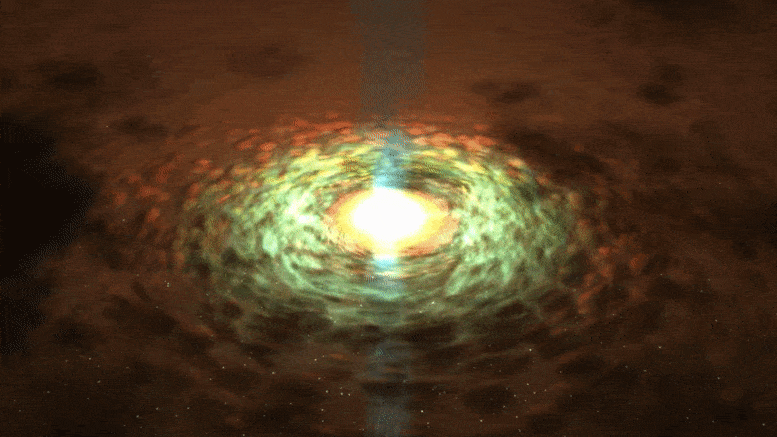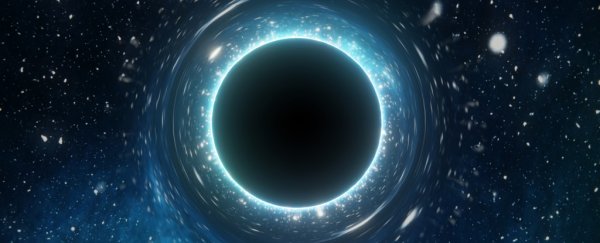
The Universe is too heavy.
According to our measurements of the normal matter in the Universe, there's not nearly enough of it to account for the strength of the gravitational effects we can see.
Whatever is making up the rest of the mass is nothing we can detect directly, and the quest to figure out what it might be is both perplexing and consuming.
The placeholder term for this mysterious mass is 'dark matter', and there are multiple hypothetical candidates. A new paper, however, is making a fresh case for a candidate first proposed in the 1970s by Stephen Hawking and Bernard Carr – primordial black holes.
"Our study predicts how the early Universe would look if, instead of unknown particles, dark matter was made by black holes formed during the Big Bang – as Stephen Hawking suggested in the 1970s," says physicist Nico Cappelluti of the University of Miami.
"This would have several important implications. First, we would not need 'new physics' to explain dark matter. Moreover, this would help us to answer one of the most compelling questions of modern astrophysics: How could supermassive black holes in the early Universe have grown so big so fast?
"Given the mechanisms we observe today in the modern Universe, they would not have had enough time to form. This would also solve the long-standing mystery of why the mass of a galaxy is always proportional to the mass of the supermassive black hole in its center."
There are several reasons why black holes are not a leading candidate for dark matter. Nevertheless, they are an attractive one (pun absolutely intended); like dark matter, these ultradense objects emit no light, and, if they are hanging about in space not eating anything, they are very hard to detect; you can only do so by observing their gravitational effect on the surrounding space-time.
One of the problems physicists face is the sheer apparent quantity of dark matter. According to our calculations, just 15 percent of the matter in the Universe is made up of normal matter. The other 85 percent is dark matter.
That's extremely challenging to make up with black holes. According to our models, stellar-mass black holes form from massive stars, and there simply aren't enough massive stars out there to even come close to generating that number of black holes. Most of the Universe's stars are titchy red dwarfs.
Primordial black holes, however, are another matter, which is why, in recent years, they have seen something of a revival as a dark matter candidate. As the name suggests, these are black holes that could have formed from overdensities in the primordial plasma that filled the Universe immediately after the Big Bang.
These black holes could be the 'seeds' from which other black holes grew – but others could also have remained small enough to escape detection.
This explanation could also help explain some other conundrums, like how supermassive black holes – ones millions to billions of times the mass of the Sun – get so huge. At the moment, the question is a head-scratcher. According to the team's calculations, these behemoths could have grown in the early Universe by merging with other primordial black holes, and accreting nearby gas and stars.
"Primordial black holes, if they do exist, could well be the seeds from which all the supermassive black holes form, including the one at the center of the Milky Way," says astronomer and physicist Priyamvada Natarajan of Yale University.
"What I find personally super exciting about this idea is how it elegantly unifies the two really challenging problems that I work on – that of probing the nature of dark matter and the formation and growth of black holes – and resolves them in one fell swoop."
Primordial black holes could even help explain a mysterious excess of infrared radiation in the Universe. According to the team, growing primordial black holes would produce the same infrared signature.
While it would certainly be nice to solve so many mysteries in "one fell swoop", there are still some questions that would need answering.
For instance, distant light bends when it has traveled to us through the gravitational field of a black hole, and we simply haven't detected this happening nearly frequently enough to account for all the black holes that would constitute 85 percent of the matter in the Universe.
It's possible that we simply haven't conducted the right kinds of surveys. And this is what the team's paper set out to do: not prove that primordial black holes exist, but to lay out a case for their existence, so we can figure out what we need to look for.
With the James Webb Space Telescope – hopefully, fingers crossed – due to launch soon, we may be able to obtain some answers.
"If the first stars and galaxies already formed in the so-called 'dark ages', Webb should be able to see evidence of them," says astronomer Günther Hasinger of the European Space Agency.
The research has been accepted into The Astrophysical Journal, and is available on preprint server arXiv.
Artistic render of a black hole. (vchal/iStock/Getty Images Plus)
When did black holes form?
Scientists think right after the big bang
Astronomers explain that black holes existed since the beginning of the Universe and that these primordial black holes could themselves be as-of-yet unexplained dark matter.
India Today Web Desk

black holes existed since the beginning of the Universe and that these primordial black holes could themselves be the as-of-yet unexplained dark matter. (File Pic)
Black holes, the objects with such high gravitational energy that nothing, not even light, can pass through, has always been the most mysterious phenomenon in astronomy and their origin has remained the biggest question. Scientists, now, speculate that supermassive black holes might have formed from the primordial black holes that came into existence right after the big bang.
In an alternative model for how the Universe came to be, a team of astronomers propose that both supermassive black holes and dark matter could be explained by so-called "primordial black holes". Their model suggests that black holes existed since the beginning of the Universe and that these primordial black holes could themselves be the as-of-yet unexplained dark matter.
In a study published in The Astrophysical Journal, the researchers said that if most of the black holes formed immediately after the Big Bang, they could have started merging in the early Universe, forming more and more massive black holes over time.
"Black holes of different sizes are still a mystery. We don’t understand how supermassive black holes could have grown so huge in the relatively short time available since the Universe existed,” explains Günther Hasinger, co-author of the study. Scientists are hopeful that when the future gravitational wave space observatory, LISA, becomes operational it might pick up the signals of those mergers if primordial black holes exist.
ADVERTISEMENT

If most of the black holes formed immediately after the Big Bang, they could have started merging in the early Universe. (Photo: ESA)
The study also points to the fact that if supermassive black holes exist, then there might also be very small black holes as well and if they do, they are too small to have formed from dying stars. Small black holes might simply be the primordial black holes that have not merged into larger ones yet.
The European Space Agency, citing the study, said that according to this model, the Universe would be filled with black holes all over. Stars would start to form around these clumps of dark matter, creating solar systems and galaxies over billions of years. If the first stars indeed formed around primordial black holes, they would exist earlier in the Universe than is expected by the standard model.
Co-author Priyamvada Natarajan of Yale University said, "Primordial black holes, if they do exist, could well be the seeds from which all black holes form, including the one at the centre of the Milky Way."
The upcoming James Webb Space Telescope will prove critical in finding answers to questions around the origin of black holes and supermassive black holes. Being dubbed as a cosmic time machine, it will look back over more than 13 billion years, shedding light on this mystery.
“If the first stars and galaxies already formed in the so-called ‘dark ages’, Webb should be able to see evidence of them,” adds Günther.
A black hole is formed from the death of a star with such a high gravitational field that the matter gets squeezed into the small space under it, trapping the light of the dead star. The gravity is so strong due to the matter being squeezed into a tiny space. Since no light can get out, people can't see black holes. They are invisible.
Black Holes Could Be Dark Matter – And May Have Existed Since the Beginning of the Universe
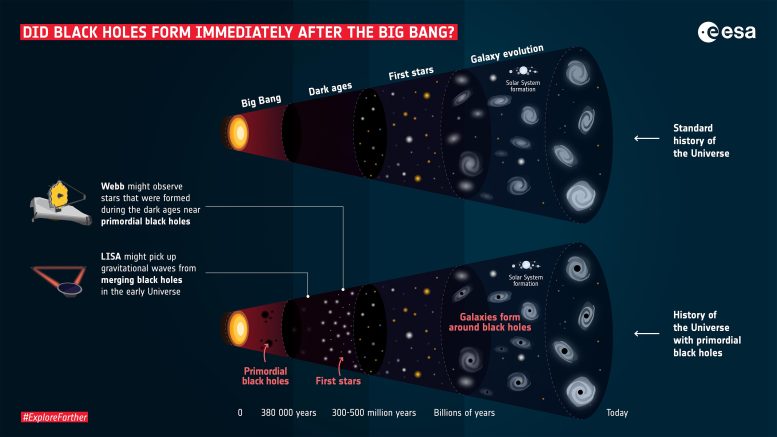
How did supermassive black holes form? What is dark matter? In an alternative model for how the Universe came to be, as compared to the ‘textbook’ history of the Universe, a team of astronomers propose that both of these cosmic mysteries could be explained by so-called ‘primordial black holes’. In the graphic, the focus is on comparing the timing of the appearance of the first black holes and stars, and is not meant to imply there are no black holes considered in the standard model. Credit: ESA
Did black holes form immediately after the Big Bang?
How did supermassive black holes form? What is dark matter? In an alternative model for how the Universe came to be, as compared to the ‘textbook’ history of the Universe, a team of astronomers propose that both of these cosmic mysteries could be explained by so-called ‘primordial black holes’.
Nico Cappelluti (University of Miami), Günther Hasinger (ESA Science Director) and Priyamvada Natarajan (Yale University), suggest that black holes existed since the beginning of the Universe and that these primordial black holes could themselves be the as-of-yet unexplained dark matter. The new study is accepted for publication in The Astrophysical Journal.
“Black holes of different sizes are still a mystery. We don’t understand how supermassive black holes could have grown so huge in the relatively short time available since the Universe existed,” explains Günther Hasinger.
At the other end of the scale, there might also be very small black holes, as suggested by observations from ESA’s Gaia, for example. If they exist, they are too small to have formed from dying stars.
“Our study shows that without introducing new particles or new physics, we can solve mysteries of modern cosmology from the nature of dark matter itself to the origin of super-massive black holes,” says Nico Cappelluti.

Two future missions in ESA’s space science program will investigate some of the most extreme phenomena in the Universe: Athena, the Advanced Telescope for High-ENergy Astrophysics, and LISA, the Laser Interferometer Space Antenna. Currently in the study phase, both missions are scheduled for launch in the early 2030s. Athena will be the largest X-ray observatory ever built, investigating some of the hottest and most energetic phenomena in the cosmos with unprecedented accuracy and depth. Meanwhile, LISA will be the first space-borne observatory of gravitational waves – fluctuations in the fabric of spacetime produced by the acceleration of cosmic objects with very strong gravity fields, like pairs of merging black holes. Credit: ESA – S. Poletti
If most of the black holes formed immediately after the Big Bang, they could have started merging in the early Universe, forming more and more massive black holes over time. ESA’s future gravitational wave space observatory, LISA, might pick up the signals of those mergers if primordial black holes exist. Small black holes might simply be the primordial black holes that have not merged into larger ones yet.
According to this model, the Universe would be filled with black holes all over. Stars would start to form around these clumps of ‘dark matter’, creating solar systems and galaxies over billions of years. If the first stars indeed formed around primordial black holes, they would exist earlier in the Universe than is expected by the ‘standard’ model.
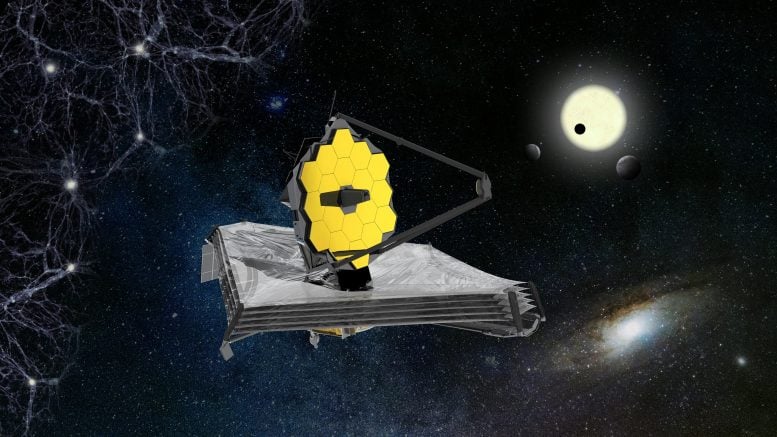
The James Webb Space Telescope is a space observatory to see further into the Universe than ever before. It is designed to answer outstanding questions about the Universe and to make breakthrough discoveries in all fields of astronomy. Webb will observe the Universe’s first galaxies, reveal the birth of stars and planets, and look for exoplanets with the potential for life. Credit: ESA/ATG medialab
“Primordial black holes, if they do exist, could well be the seeds from which all black holes form, including the one at the center of the Milky Way,” says Priyamvada Natarajan.
ESA’s Euclid mission, which will probe the dark Universe in greater detail than ever before, could play a role in the quest to identify primordial black holes as dark matter candidates.
The upcoming NASA/ESA/CSA James Webb Space Telescope, a cosmic time machine looking back over more than 13 billion years, will further shed light on this mystery.
“If the first stars and galaxies already formed in the so-called ‘dark ages’, Webb should be able to see evidence of them,” adds Günther.
Reference: “Exploring the high-redshift PBH-ΛCDM Universe: early black hole seeding, the first stars and cosmic radiation backgrounds” by N. Cappelluti, G. Hasinger and P. Natarajan, Accepted, The Astrophysical Journal.
arXiv:2109.08701
Astronomers just got better at finding 'bright' black holes
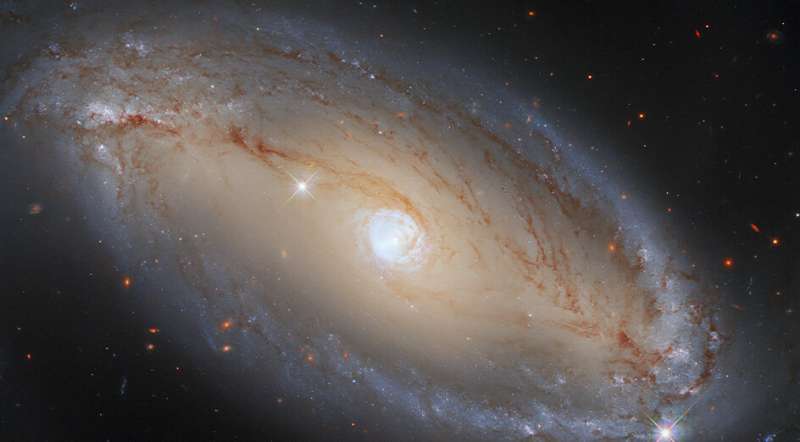
Astronomers have a new way of detecting active black holes in the Universe and measuring how much matter they are sucking in.
The technique can be applied to millions of galaxies, searching for bright, supermassive black holes at the center of the galaxies.
Lead author Jessica Thorne, a Ph.D. student at the University of Western Australia node of the International Centre for Radio Astronomy Research, said active black holes are typically found in the largest galaxies in the Universe.
"The black holes we're looking for are between a million and a billion times more massive than our Sun," she said.
"As they suck in matter from around them, the matter gets super-heated because of friction and becomes very, very luminous."
"And when they're active, these black holes can outshine the rest of the galaxy."
Until now, identifying bright black holes has been challenging, with astronomers having to specifically look for them using complex methods unique to different types of telescopes.
Instead, the new technique works on typical telescope observations that already exist for millions of galaxies.
"We can identify these active black holes and look at how much light they're emitting, but also measure the properties of the galaxy it is in at the same time," Ms Thorne said.
"By doing both at once, we can have a better idea of exactly how the black hole is impacting its host galaxy."
The researchers developed the new technique by using an algorithm called ProSpect to model emission from galaxies and black holes at different wavelengths of light.
They then applied the method to almost half a million galaxies from Anglo-Australian Telescope's DEVILS survey.
They also applied it to more than 200,000 galaxies from the GAMA survey, which brings together observations from six of the world's best ground and space-based telescopes.
ICRAR-UWA astronomer Dr. Sabine Bellstedt said scientists often fail to account for bright black holes in galaxies.
"One of the reasons we've ignored them in the past is because it's hard to find them all," she said.
"We don't really understand these bright black holes to incorporate them into our modeling with sufficient detail."
Dr. Bellstedt said the new technique is easier, more consistent and more thorough.
"It suddenly means we can look for active black holes in so many more places than we were able to before," she said.
"It's going to help us search more galaxies, and look further back in time to the distant Universe."
Supermassive black holes are thought to have a huge impact on how galaxies evolve.
"We think that an active black hole in a galaxy is able to decrease the amount of star formation really quickly and stop the galaxy from growing any further," Thorne said. "It can effectively kill it."
With observations from new telescopes such as the James Webb Space Telescope, the Vera C. Rubin Observatory in Chile, and the Square Kilometre Array in Australia and South Africa, astronomers may be able to apply the technique to millions of galaxies at once.
"It's exciting to think about how many doors this has unlocked for the future," Thorne said.
The research was published in Monthly Notices of the Royal Astronomical Society.
Astronomers discover how to feed a black hole
More information: Jessica E Thorne et al, Deep Extragalactic VIsible Legacy Survey (DEVILS): identification of AGN through SED fitting and the evolution of the bolometric AGN luminosity function, Monthly Notices of the Royal Astronomical Society (2021). DOI: 10.1093/mnras/stab3208
Journal information: Monthly Notices of the Royal Astronomical Society
Provided by University of Western Australia
Not all black holes are black – and we have found thousands of the brightest ones
Sometimes materials such as gas, dust or stars that get sucked into the celestial objects heat up and become incredibly bright.
Jessica Thorne, The Conversation & Sabine Bellstedt, The Conversation
Dec 15, 2021 ·

When the most massive stars die, they collapse to form some of the densest objects known in the universe: black holes. They are the “darkest” objects in the cosmos, as not even light can escape their incredibly strong gravity.
Because of this, it is impossible to directly image black holes, making them mysterious and quite perplexing. But our new research has road-tested a way to spot some of the most voracious black holes of all, making it easier to find them buried deep in the hearts of distant galaxies.
Despite the name, not all black holes are black. While black holes come in many different sizes, the biggest ones are at the centres of galaxies and are still growing in size.
These “supermassive” black holes can have a mass of up to a billion Suns. The black hole at the centre of our own Milky Way galaxy – called Sagittarius A*, whose discovery received the 2020 Nobel Prize in Physics – is fairly calm. But that is not the case for all supermassive black holes.
If materials such as gas, dust or stars get too close to a black hole, it gets sucked in by the enormous gravitational force. As it falls towards the black hole, it heats up and becomes incredibly bright.
The light produced by these “bright black holes” can span the entire electromagnetic spectrum, from X-rays to radio waves. Another name for the bright black holes at the centre of galaxies is “active galactic nuclei”, or AGN. They can shine trillions of times brighter than the Sun, and can sometimes even outshine all the stars in its galaxy.

Brightest black holes
Some active galactic nuclei violently spew out matter via a jet, which travels millions of kilometres through space and can be seen by radio telescopes. Others produce “winds” at the centre of the galaxy, capable of pushing any gas (the fuel needed for stars to form) out of the galaxy.

With such destructive forces in the middle of a galaxy, astronomers are certain this must have a big impact on the galaxy itself. We know most galaxies are slowly turning off their star formation processes and active galactic nuclei might be one of the culprits.
Active galactic nuclei can therefore not only help us to better understand elusive black holes but studying them also teaches us about galaxies themselves.
Finding black holes
Depending on how much a black hole is “eating”, what galaxy it is in and the angle from which we can see it, active galactic nuclei can look very different to one another. Even when looking at the same galaxy, one astronomer with an X-ray telescope may see it glow and discover an active galactic nucleus, whereas another astronomer using a radio telescope might see nothing, if the active galactic nuclei do not happen to produce jets that are visible in the radio spectrum.
Because of this, it was thought they were all different objects, but by looking at the same objects with different telescopes astronomers discovered they had many similarities and realised the benefits of using more of the electromagnetic spectrum to find them.
The relative brightness of a galaxy across different parts of the electromagnetic spectrum is called its “spectral energy distribution”. This can be used to measure how many stars are in a galaxy, how old they are, what they are made of and how much dust is blocking the light

In our research, published today in Monthly Notices of the Royal Astronomical Society, we show that this technique can also be used to spot active galactic nuclei. This means we can now measure not just the properties and histories of the stars in the galaxy, but also the brightness of its central black hole.
It is not a simple thing to do. The difference between starlight and the light from an active galactic nucleus is incredibly subtle, so it is possible to confuse young stars for a bright black hole and vice versa.
Here in Australia, astronomers have been using Australian telescopes to make 3D maps of galaxies in specific patches of the sky. These maps let us scour hundreds of thousands of galaxies, spanning 11 billion years of history, for possible active galactic nuclei.
By applying our new method to 700,000 galaxies we identified and quantified more than 75,000 active galactic nuclei to begin understanding how their number has evolved over time and how they have impacted their host galaxies. Astronomers think the number of active galactic nuclei in the universe is linked to the amount of star formation, which we know was almost ten times higher roughly 10 billion years ago. But until we can be certain we have identified all the active galactic nuclei across cosmic time in our galaxy samples, we will not know for sure.
Right now, the astronomical community is still passionately debating the nature of active black holes. While we have not yet answered the questions needed to soothe the debate, we are now one step closer to reliably being able to spot these fascinating objects within galaxies. And that is an important step towards shedding more light on the mystery of black holes.
Jessica Thorne is an Astrophysics PhD Candidate and Sabine Bellstedt is a Research Associate in Astronomy at The University of Western Australia.
